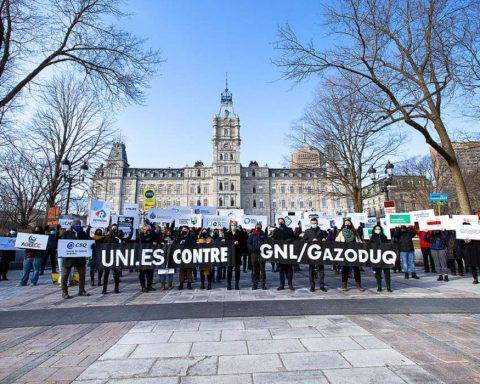Corporate Knights and the Council for Clean Capitalism today released draft Clean Transition Bonds Guidelines – a crucial first step in establishing an important new category of green bonds. CTBs will be instrumental in enabling Canada’s energy and other carbon-intensive industries to further reduce their emissions, while at the same time leveraging massive opportunities for process improvement and new product development.
The CTB Guidelines cover the oil and gas, mining and metals, heavy industry, and energy utilities sectors. They resulted from an extensive consultative and collaborative effort over the course of 2018, and reflect input from over 40 bond issuers, raters, underwriters and institutional investors. Their creation aligns with a recommendation made today by the federal government’s Expert Panel on Sustainable Finance. “Green transition bonds and loans are markets where Canada can lead the world,” said Tiff Macklem, Expert Panel Chair, adding “this is an opportunity for us to be shapers, not takers.” Canadian Minister of Finance, Bill Morneau, followed up these comments remarking that “there is a huge opportunity for Canada’s financial sector to become stronger,” by leading the charge on sustainable finance. “Our financial sector is stepping up. We can be the country finding and financing the solutions,” said Canadian Minister of Environment and Climate Change, Catherine McKenna, noting that meeting the climate change challenge represents a $26 trillion global growth opportunity.
The CTB Guidelines define sector-specific categories of activities, which reduce carbon or otherwise improve environmental outcomes, while often also establishing market advantages or new products and revenue streams. For downstream oil and gas companies, for example, qualifying project categories include emissions-intensity reductions in refining, development of bio-based polymer products, renewable jet fuels, and development of electric- and hydrogen-vehicle fueling infrastructure. The guidelines define the maximum percentage of proceeds from a CTB issue that can be directed to each activity, ranging from 25 to 100 per cent, depending on the activity’s impact.
“There’s strong and growing investor interest in financing projects that help address the carbon challenge and that reduce stranded-asset risk,” said a statement issued by the Council for Clean Capitalism. “These guidelines will help ensure that some of Canada’s most important industries can tap into green capital flows as they transition to a clean-growth future. And since these industries account for most of our carbon emissions, targeted investment will be hugely helpful in meeting our climate-related goals.”
Concurrent with development of the CTB Guidelines, Corporate Knights analyzed the scope of opportunities for non-combustion uses of bitumen from the Alberta oilsands (using data provided by Alberta Innovates). Some of the most promising product types leverage some of the same attributes that result in bitumen’s heavier footprint when burned, and include use of carbon fibres for steel replacement and in concrete and wood composites, along with pelletized asphalt.
With sufficient investment – through CTBs and other means – the annual market value of just these four product lines could be US$218 billion by 2030. The analysis suggests an annual market opportunity of US$1.5 trillion by 2030 based on a wider range of sustainable commodities derived from bitumen and other abundant feedstocks (see below).
Unlocking this market opportunity will require significant investments of at least $US$1.8 trillion between now and 2030, Corporate Knights estimated based on industry data assembled by Alberta Innovates. The scope of that investment requirement underscores the need to increase capital flows towards transition activities in high-carbon industries, Heaps said.
“Sustainable finance is about speeding up the transition to a low-carbon economy consistent with the Intergovernmental Panel on Climate Change recommendations to keep global temperature increases below 1.5°C,” said Sean Kidney, CEO of the Climate Bonds Initiative, an international NGO working to mobilise debt capital markets for climate solutions. “These draft guidelines are an important contribution to enabling full participation in that opportunity across carbon-intensive industries.” He adds that financing transition activities of carbon-intensive sectors is a global priority, and that the initiative announced today creates the potential for Canada to shape emerging global norms around clean transition finance.
A roundtable discussion co-hosted by the federal Expert Panel, and Toronto Finance International is scheduled in Toronto for November 16, at which refinement of the draft CTB Guidelines released today will be discussed. “We would ultimately like to see some form of federal endorsement of the finalized guidelines,” Heaps said, adding they will likely be updated on an annual basis.
Canadian green bond labeled issues – currently typically focused on projects such as renewable energy and transit and other forms of sustainable infrastructure – reached a new record of C$3.8 billion in 2017. Demand from investors continues to outstrip supply even as new private and public issuers enter the market. Global green bond issues are expected to total US$210 billion in 20181
| Product | Technological Readiness (1-10) | Market Size US$B | Production Quantity | Major Players (current & Cdn potential) |
|---|---|---|---|---|
| Carbon fibres from bitumen for steel replacement | 2 | $130 | 26 MT at $5000/ton | Suncor, Nexen, Husky, CNRL, MEG, Imperial, Cenovus |
| Carbon fibres from bitumen in concrete composites | 2 | $47 | $9.4 MT at $5000/ton | Suncor, Nexen, Husky, CNRL, MEG, Imperial |
| Cleaner oil with >50% reduction in emissions intensity | 2-8 | $24.60 | 1.35m bpd at $50/bbl | CNRL, Suncor, IOL, Cenovus, Devon Energy, COP, MEG, Husky, Nexen |
| Carbon fibres from bitumen in wood composites | 2 | $35 | 7 MT at $5000/ton | Suncor, Nexen, Husky, CNRL, MEG, Imperial Oil, Al-Pac, Canfor, Millar Western, Tolko Industries, West Fraser Timber, Weyerhaeuser |
| Pelletized asphalt from bitumen | 3 | $5.80 | 10.5 MT at $550/ton | Husky, Suncor, Imperial Oil, CNRL |
| Bioethanol (1st gen) | 10 | $254 | 254b litres @$1/l | Suncor, Greenfield Global, Permolex, Husky, North West Bioenergy, Pound-Maker Agventures, Terra Grain Fuels |
| Cellulosic Ethanol | 8 | $254 | 254b litres @$1/l | Enerkem, Iogen |
| Renewable Natural Gas | 10 | $209 | 18 EJ @$11.64/GJ | BC Fortis, ATCO, Lethbridge BioGas, XeBec (Quebec), Alberta pulp & paper industry |
| Carbon Capture and Use (CCU) Cement and Aggregates | 6-9 | $165 | 7500 MT @$22/t | Burnco, Carbicrete, Carbon Cure, Solidia, Carbon Upcycling Technologies |
| Renewable Jet Fuel | 7-10 | $84 | 135b litres @$779/t | WestJet, Air Canada, Petrochemical/Waste/Ag industries |
| Biodiesel | 7-10 | $117 | 116b litres @$1140/t | Atlantic Biodiesel Coop, Biox Corp, Invifoe Bioenergy Corp, ArcherDaniels Midland Co |
| Biomethanol (for petrochemicals) | 9-10 | $67 | 156b litres @0.43/l | Enerkem, Al-Pac, BioMCN (Netherlands) |
| Renewable Hydrogen | 7-9 | $31 | 10.8 MT @$2850/MT | Hydrogenics, Nel Hydrogen, Linde (Germany), BASF (Germany) |
| Bioplastics & Biopolymers | 6-10 | $14 | Various | University of Guelph, BASF |
| CCU Methanol | 4-8 | $12 | 34 MT @$353/t | Methanex, Mitsui Chemicals (Japan), Carbon Recycling International (Iceland) |
| Biomass Pellets | 10 | $11 | 67 MT @$168.61/t | Canfor, Millar Western, Tolko Industries, West Fraser Timber, Weyerhaeuser |
*based on an aggressive investment scenario facilitated through Clean Transition Bonds and other means
[1] Bonds & Climate Change 2017: Canada Report; and Climate Bonds InitiativeSource: Corporate Knights analysis using data from Alberta Innovates.







